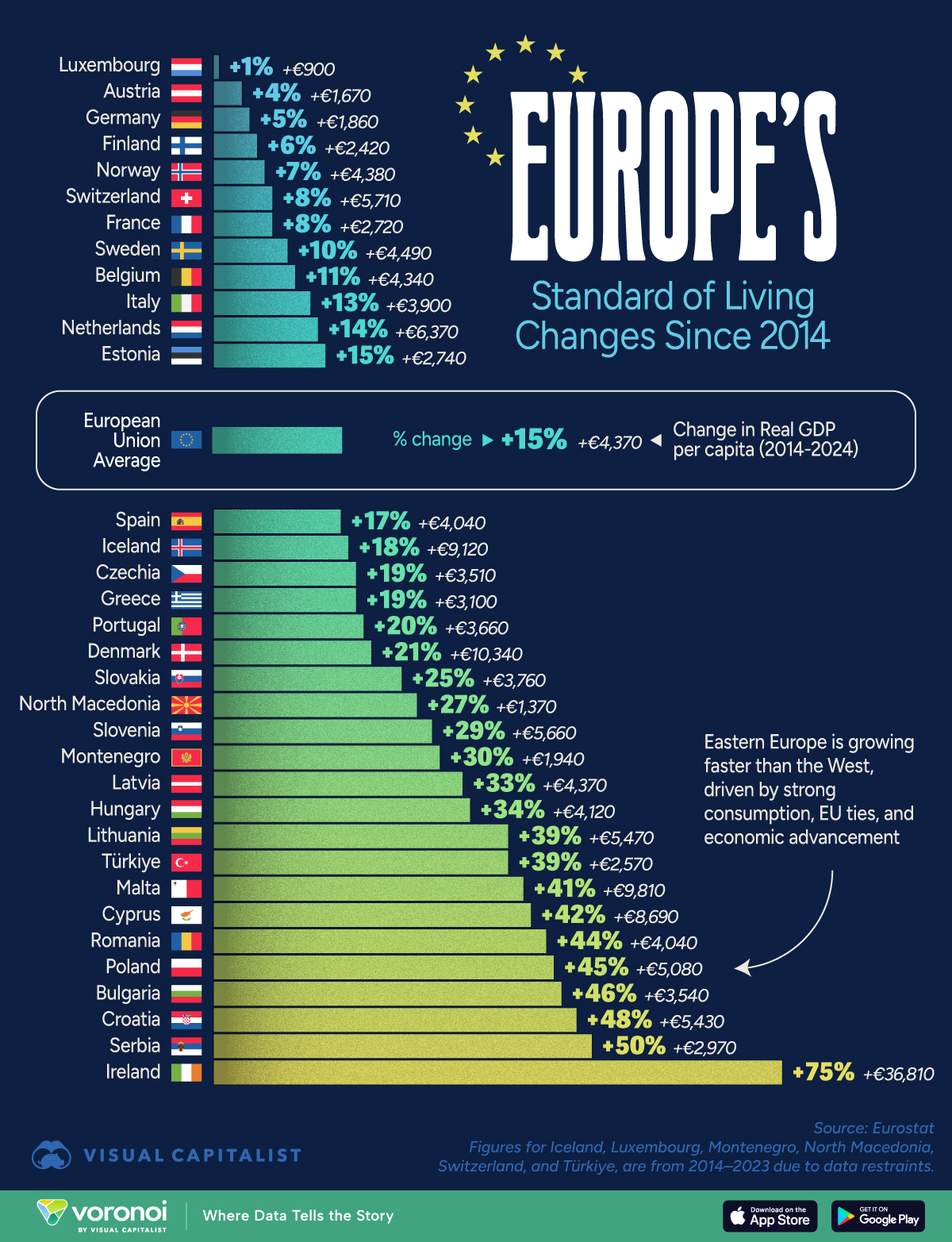A Decade of Living Standard Gains in 34 European Countries
This was originally posted on our Voronoi app. Download the app for free on iOS or Android and discover incredible data-driven charts from a variety of trusted sources.
Key Takeaways
- Eastern European countries have seen the largest increases in living standards—or real economic productivity—since 2014.
- The entire Balkan region, and former Soviet bloc countries, have seen their per capita GDPs rise between 25–50% since 2014.
- The only Western European country that has seen such a big change is Ireland.
Economic growth in absolute terms is all well and good, but where have living standards actually improved in Europe?
To answer that question, we visualize the closest data point, change in GDP per capita for 36 European countries, with figures adjusted for inflation and expressed in 2020 euros.
Data is sourced from Eurostat and there are a few notes to keep in mind when viewing the chart:
- Eurostat no longer publishes comparative figures for the UK.
- Change figures for Iceland, Luxembourg, Montenegro, North Macedonia, Switzerland, and Türkiye are from 2014–2023 due to data restraints.
- If a European country is missing from this list, it’s because figures were unavailable for either 2014 or 2023/24.
Ranked: Real GDP per Capita Growth, by European Country
Aside from Ireland, (+75%), most of the European countries with the largest increases in real GDP per capita can be found in Eastern and Southern Europe.
| Rank | Region/Country | GDP Per Capita % Growth (2014–2024) |
Real GDP per Capita Growth (2014–2024) |
|---|---|---|---|
| 1 |  Ireland Ireland |
75% | €36,810 |
| 2 |  Serbia Serbia |
50% | €2,970 |
| 3 |  Croatia Croatia |
48% | €5,430 |
| 4 |  Bulgaria Bulgaria |
46% | €3,540 |
| 5 |  Poland Poland |
45% | €5,080 |
| 6 |  Romania Romania |
44% | €4,040 |
| 7 |  Cyprus Cyprus |
42% | €8,690 |
| 8 |  Malta Malta |
41% | €9,810 |
| 9 |  Türkiye Türkiye |
39% | €2,570 |
| 10 |  Lithuania Lithuania |
39% | €5,470 |
| 11 |  Hungary Hungary |
34% | €4,120 |
| 12 |  Latvia Latvia |
33% | €4,370 |
| 13 |  Montenegro Montenegro |
30% | €1,940 |
| 14 |  Slovenia Slovenia |
29% | €5,660 |
| 15 |  North Macedonia North Macedonia |
27% | €1,370 |
| 16 |  Slovakia Slovakia |
25% | €3,760 |
| 17 |  Denmark Denmark |
21% | €10,340 |
| 18 |  Portugal Portugal |
20% | €3,660 |
| 19 |  Greece Greece |
19% | €3,100 |
| 20 |  Czechia Czechia |
19% | €3,510 |
| 21 |  Iceland Iceland |
18% | €9,120 |
| 22 |  Spain Spain |
17% | €4,040 |
| 23 |  Estonia Estonia |
15% | €2,740 |
| 24 |  Netherlands Netherlands |
14% | €6,370 |
| 25 |  Italy Italy |
13% | €3,900 |
| 26 |  Belgium Belgium |
11% | €4,340 |
| 27 |  Sweden Sweden |
10% | €4,490 |
| 28 |  France France |
8% | €2,720 |
| 29 |  Switzerland Switzerland |
8% | €5,710 |
| 30 |  Norway Norway |
7% | €4,380 |
| 31 |  Finland Finland |
6% | €2,420 |
| 32 |  Germany Germany |
5% | €1,860 |
| 33 |  Austria Austria |
4% | €1,670 |
| 34 |  Luxembourg Luxembourg |
1% | €900 |
| N/A |  European Union European Union |
15% | €4,370 |
Ireland’s GDP metrics are heavily influenced by external factors: namely profit shifting and intellectual property leasing by multinational corporations headquartered in the country.
This inflates GDP numbers far beyond actual economic activity within the country. Thus, the growth listed doesn’t accurately reflect an equal change in living standards. The Irish government prefers to use gross national income as a barometer for the country.
However, Eastern Europe has seen rising living standards, and growing economic productivity in the last decade. This is driven in part by Western EU countries shifting supply chains and manufacturing east, creating jobs, and raising average incomes and related consumption.
But also, base effects matter when looking at growth. For example, Serbia’s GDP per capita rose 50%. In currency terms this is a €3,000 increase.
France saw a similar euro gain, but because of its higher starting point, it registered as an 8% increase.
The Polish Miracle
Poland has long been Europe’s poster child for free-market integration.
Since the fall of the Berlin wall, it saw uninterrupted economic growth for 28 straight years until 2020.
This growth has been supercharged by EU accession in 2004, becoming a high-income country just 15 years after being classified as a middle income one.
Poland prioritized strong institutions, which later attracted European investment that set up its manufacturing facilities. As a result, wages have increased, the standard of living has improved, and the economy has grown.
However Poland’s dependence on Germany—its largest trading partner—has revealed vulnerabilities in its economy.
Learn More on the Voronoi App 
Keep up with our European coverage, from economy to wealth to happiness! Check out: Europe’s Happiest Countries for quick insight into why the Nordics always do so well in this report.
The post Ranked: Where Living Standards Are Rising in Europe (2014–2024) appeared first on Visual Capitalist.

